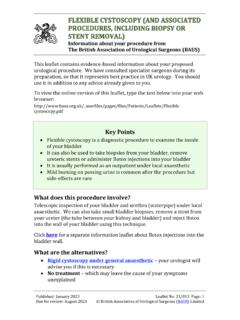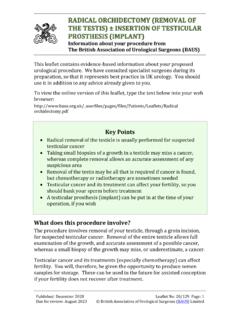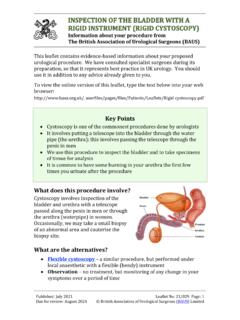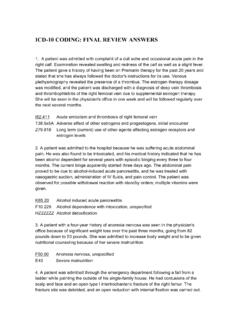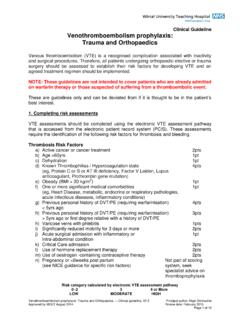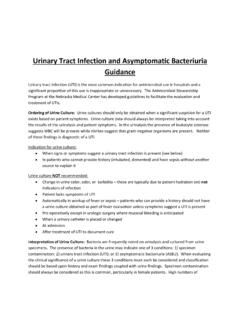Transcription of Key Points - BAUS
1 Information about your procedure from The British Association of Urological Surgeons (BAUS) Published: June 2020 Leaflet No: 20/003 Page: 1 Due for review: June 2023 British Association of Urological Surgeons (BAUS) Limited This leaflet contains evidence-based information about your proposed urological procedure. We have consulted specialist surgeons during its preparation, so that it represents best practice in UK urology. You should use it in addition to any advice already given to you. To view the online version of this leaflet, type the text below into your web browser: What does this procedure involve? Botulinum toxin-A injections are used to treat overactive bladder (OAB). Patients with OAB have a sudden, strong feeling of needing to pass urine (urgency) and sometimes urine leakage (incontinence) associated with urgency.
2 Usually, patients need to pass urine frequently. The procedure is not a treatment for stress urinary incontinence (leakage of urine when you exercise, sneeze or strain). The procedure involves passing a telescope into your bladder, through your urethra (waterpipe), and giving several injections of Botox (botulinum Key Points Botulinum toxin-A bladder injections are performed to treat overactive bladder We put several injections of Botulinum toxin-A into the wall of your bladder using a telescope put in through your urethra (waterpipe) The injections can sometimes be uncomfortable but the procedure only takes a few minutes The procedure is commonly performed in the outpatient clinic under local anaesthetic Some patients have difficulty passing urine afterwards and you may need to use a disposable catheter to empty your bladder.)
3 This may last for several weeks or months but is rarely permanent The commonest after-effect is urine infection Botulinum toxin-A injections are usually effective for 4 - 12 months, but the procedure can be repeated at that time Published: June 2020 Leaflet No: 20/003 Page: 2 Due for review: June 2023 British Association of Urological Surgeons (BAUS) Limited toxin-A) into your bladder wall. Botox prevents your bladder muscle from contracting (squeezing) too much. This should help you to hold on better and will increase the amount of urine your bladder can store. Currently, there is one licensed product (OnabotulinumtoxinA), with a recommended starting dose of 100U for patients with OAB where there is no obvious cause, and 200U for patients with OAB due to a neurological cause ( interruption or damage to the nerves that go to the bladder from the brain and spinal cord).
4 What are the alternatives? Overactive bladder can be treated with having an operation. We recommend that all patient try conservative treatments before having an operation because this avoids the risk of side-effects or complications of surgery. Incontinence pads if your symptoms are not a bother, you may choose to do nothing and use incontinence pads for urine leakage Conservative measures including weight loss, improving fluid intake and reducing caffeine and alcohol Bladder training learning techniques to hold on and over-ride your urge to pass urine Medicines - these may help if conservative treatment does not work Botulinum toxin-A injections are usually only tried if the treatments are not effective.
5 Other procedures that can be used instead of Botox injections include: Sacral nerve stimulation a device implanted in your lower back that sends electrical signals to the bladder nerves Posterior tibial nerve stimulation, PTNS (electrical stimulation of a nerve near your ankle) can be used, but is not widely available on the NHS Enterocystoplasty a major operation that enlarges your bladder using a piece of bowel What happens on the day of the procedure? You will be seen by the surgeon who will go through the plans for your procedure with you. If you are having a general anaesthetic, an anaesthetist will also see you and will discuss pain relief after the procedure. Published: June 2020 Leaflet No: 20/003 Page: 3 Due for review.
6 June 2023 British Association of Urological Surgeons (BAUS) Limited Details of the procedure we normally use a local anaesthetic gel squirted into your urethra (waterpipe) although, sometimes, a general anaesthetic is needed ( with you asleep) we put a telescope into your bladder through your urethra and give a number of injections of Botulinum toxin-A into your bladder wall (pictured above) the injections are not usually painful but some patients find them uncomfortable you can usually go home shortly after the procedure the injections usually work within days but they can take up to two weeks to work How effective is the procedure in curing overactive bladder? Botulinum toxin-A injections are effective in over seven out of 10 patients (70%), meaning that their urgency and incontinence are either significantly better or cured.
7 The effects of the injections last for around four to 12 months and then your symptoms start to return. You can have further injections when this happens. There is no limit to how many times you can have injections, and most people find that having repeat injections works well over many years. Are there any after-effects? The possible after-effects and your risk of getting them are shown below. Some are self-limiting or reversible, but others are not. We have not listed very rare after-effects (occurring in less than 1 in 250 patients) individually. The impact of these after-effects can vary a lot from patient to patient; you should ask your surgeon s advice about the risks and their impact on you as an individual: After-effect Risk Symptoms return after 4 - 12 months, requiring repeat injections Almost all patients Published: June 2020 Leaflet No: 20/003 Page: 4 Due for review: June 2023 British Association of Urological Surgeons (BAUS) Limited What is my risk of a hospital - acquired infection?
8 Your risk of getting an infection in hospital is between 4 this includes getting MRSA or a Clostridium difficile bowel infection. Individual hospitals may have different rates, and the medical staff can tell you the risk for your hospital . You have a higher risk if you have had: long-term drainage tubes ( catheters); long hospital stays; or multiple hospital admissions. Mild burning on passing urine for 24 hours after the procedure Almost all patients Bleeding in the urine for 1 - 3 days after the procedure Almost all patients Failure of the treatment to improve overactive bladder symptoms Around 3 out of 10 patients (30%) Difficulty passing urine after the procedure which may require intermittent self-catheterisation (more likely with higher doses) Between 1 in 5 & 1 in 15 patients (6 - 20%) Infection of the bladder requiring antibiotic treatment Between 1 in 6 & 1 in 7 patients (15%) Recurrent urinary tract infections Between 1 in 10 & 1 in 50 patients Allergic reaction to Botox (with difficulty breathing, swallowing and speaking)
9 Requiring emergency treatment Less than 1 in 250 patients Generalised weakness of the legs & arms due to the Botox (usually settles without admission or treatment) Less than 1 in 250 patients Published: June 2020 Leaflet No: 20/003 Page: 5 Due for review: June 2023 British Association of Urological Surgeons (BAUS) Limited What can I expect when I get home? you will be given advice about your recovery at home you will be given a copy of your discharge summary and a copy will also be sent to your GP if you have had a bladder catheter inserted, we will arrange an appointment for it to be removed any other tablets you need will be arranged & dispensed from the hospital pharmacy you can return to normal daily life almost immediately you may return to work when you are comfortable enough if you develop a fever, frequent passage of urine, severe pain on passing urine, inability to pass urine or worsening bleeding, you should seek medical attention.
10 General information about surgical procedures Before your procedure Please tell a member of the medical team if you have: an implanted foreign body (stent, joint replacement, pacemaker, heart valve, blood vessel graft); a regular prescription for a blood thinning agent ( warfarin, aspirin, clopidogrel, rivaroxaban, dabigatran); a present or previous MRSA infection; or a high risk of variant-CJD ( if you have had a corneal transplant, a neurosurgical dural transplant or human growth hormone treatment). Questions you may wish to ask If you wish to learn more about what will happen, you can find a list of suggested questions called "Having An Operation" on the website of the Royal College of Surgeons of England.



